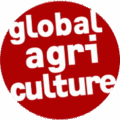
In the first place, hunger is a lack of calories. A healthy diet, however, does not only consist of enough energy but also a balanced mix of proteins, carbohydrates and fats as well as a large variety of essential micronutrients, such as iron, zinc, iodine, minerals and vitamins. Worldwide, two billion people are suffering from one or even several micronutrient deficiencies, with often fatal consequences. Short-term emergency measures, such as distributing vitamin A to pregnant women and infants, can save lives in acute cases and alleviate symptoms. Adding micronutrients to foods can also help. The key to a balanced and healthy diet, however, lies in the cultivation and consumption of a range of plants and other products with different vitamins and minerals, as well as in a way of processing food that preserves the quality of its ingredients. This holds true for both the food self-sufficiency in rural areas and highly processed foods in urban supermarkets.
Malnutrition and obesity
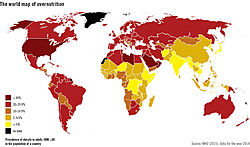
In 2016, 1.9 billion people worldwide were overweight; more than one third of them were obese. Over the past decades, this “global epidemic”, as it is called by the WHO, has been spreading rapidly. A major driver of being overweight or obese is the consumption of energy-dense foods in combination with a lack of physical activity. In 1975, just one in five of all adults was overweight; in 2016, 39% of the world population was affected, not only in industrialised nations but also in emerging economies and developing countries. Being overweight is considered a major cause of chronic conditions such as diabetes, high blood pressure, strokes and certain cancers.
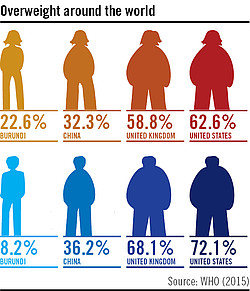
Between them, undernutrition, obesity and malnutrition are responsible for most non-communicable diseases and health problems. They afflict almost half of the world’s population, albeit to different extents. What is more, they have a common root cause, namely the separation and disconnection of food production from consumption.
The IAASTD argues that it is essential to re-establish these links at all levels in order to bring food providers and consumers closer together. The fine cuisines of this world could show us the way. Many plant-based products, a few but high-quality animal products and as much variety as possible are the secret of Tuscan, Chinese, Indian and Oriental top chefs, who make use of the rich traditions of simple regional cuisines.
The IAASTD underlines that public policies, too, could help to ensure diet quality and diversity: they should be refocused to improve nutrition and public health.

Food safety regulations and laws forbidding the contamination of drinking water are among the oldest laws in the world. The IAASTD warns that food safety in developing and industrialised countries is increasingly threatened by new and persistent dangers. Microbial food contamination from bacteria (e.g. E. coli, staphylococcus, salmonellae), fungi, viruses or parasites is currently topping the list of health hazards, often leading to acute symptoms. Food scandals are no more than the tip of the iceberg. Exposure to or poisoning from pesticides, heavy metals and other residues, such as dioxins, polychlorinated biphenyls (PCB) or synthetic hormones, often goes unnoticed due to the length of time it takes for symptoms to develop. If chronic symptoms appear subsequently, it is often difficult to identify the exact causes in individual cases. This also applies to the effects and the interaction of a large number of new chemical substances and food additives to which consumers are exposed today. New disorders and conditions such as allergies, hyperactivity and certain types of cancer are on the rise.
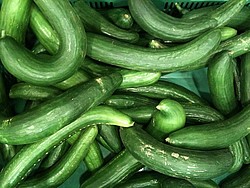
The increasingly expensive and complex technical safety standards, established in response to the growing health hazards of the global food system, bring with them a number of negative consequences. Small-scale producers are unable to comply with the requirements of sophisticated traceability and labelling systems, which were created by industrialised nations and international corporations to monitor food from farm to fork. These standards, for example the guidelines of the Codex Alimentarius established by FAO and WHO or the sanitary and phytosanitary measures (SPS) of the World Trade Organisation have the effect of concentrating the market. In industrialised countries, they degrade traditional forms of food production and thus food quality. Developing countries are often unable to bear the cost of such hygiene standards and monitoring systems. As a result, they are commonly applied exclusively to export goods, while simple and effective local security measures are not introduced.
Agriculture – a dangerous sector
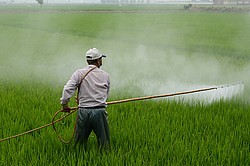
Agriculture, apart from mining and construction, is one of the most hazardous sectors to work in. Of the millions of accidents occurring in agriculture, at least 170,000 agricultural workers die in work-related accidents each year. The main causes of accidents are farm machinery and poisoning by pesticides or other agrochemicals: however, physical overload, noise, dust, allergies and infectious diseases transmitted between animals and humans also need to be taken into account. The International Labour Organisation estimates that 59% of all child labourers work in agriculture, amounting to over 98 million girls and boys worldwide. The number of unreported cases is particularly high in this sector.
New and persistent dangers
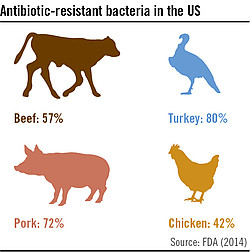
Infectious diseases transmitted between animals and humans rank among the most serious health risks in agriculture. Certain methods of cultivation favour outbreaks of these zoonotic diseases. Irrigation methods, for example, play a substantial role in the spread of malaria or other insect-borne diseases. Most victims of these diseases are women and children in rural areas, who do not have the means to prevent or treat such diseases. Both private and public research frequently focuses on those illnesses which primarily affect wealthier populations in cities and industrialised countries.
An additional danger to human health is the increasing antimicrobial resistance arising from the use of antibiotics in industrialised farming systems. As long ago as 1997, the WHO warned against the sub-therapeutic use of antibiotics in livestock production, as the development of resistant strains of bacteria make diseases untreatable with antibiotics. In a new report released in 2012, the WHO reiterated its warning about the growing threat of antimicrobial resistance.
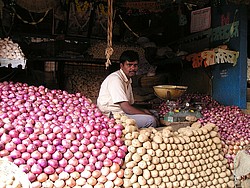
The IAASTD contends that agriculture and nutrition are the foundations of human health. At the same time, they are a major cause of disease in both rich and poor countries. Healthy and sustainable diets, safe methods of food production and sustainable agriculture could prevent suffering and premature death for millions of people. These are also decisive factors for a solid economic upturn in developing countries and an effective way to reduce escalating costs in the healthcare systems for industrialised countries. One of the key messages of the IAASTD is that sustainable and healthy diets can only be achieved where consumption (demand) and production are developed together instead of separately. This message is no longer a contentious issue from a scientific point of view, but putting it into practice is inhibited by powerful economic interests.
Facts & Figures
According to the latest WHO estimates, 2.5 billion people aged 18 or above were overweight in 2022. Of this number, more than 890 million people were obese. Around 37 million children under the age of five were overweight. Being overweight or obese is a major risk factor for noncommunicable diseases such as diabetes, certain cancers and cardiovascular diseases. In 2019, higher-than-optimal body mass index (BMI) caused an estimated 5 million deaths from noncommunicable diseases.
The worldwide prevalence of overweight among adults has risen dramatically from 21.5 % in 1975 to 39% in 2016. The prevalence of obesity nearly tripled over the same period: In 1975, just 4.7% of all adults was obese; in 2016, the figure was 13.1%.
If current trends continue, 2.7 billion adults worldwide will be overweight or obese by 2025. 17% of the world’s adults or almost 1 billion people are projected to be obese by 2025. On current trends, 177 million adults will be severely obese with a BMI above 35 and in need of treatment.
Feeding 10 billion people by 2050 with a healthy and sustainable diet is possible but dietary patterns need to change, says the EAT-Lancet Commission. The “planetary health diet” requires global consumption of foods such as red meat and added sugars to decrease by about 50%, while the intake of nuts, fruits, vegetables, and legumes must double. This diet allows an average of 2,500 calories per day and consists of about 35% of calories as whole grains and tubers, and protein mainly derived from plants. It includes only 14g of red meat per day but 500g per day of fruit and vegetables.
Our food systems have failed to address hunger and encourage diets that are a source of obesity. The former UN Special Rapporteur on the Right to Food has made a series of recommendations that include: taxing unhealthy products; regulating foods high in saturated fats, salt and sugar; cracking down on junk food advertising; overhauling agricultural subsidies that make certain ingredients cheaper and supporting local food production, so that consumers have access to healthy, fresh and nutritious foods.
More than half of all adults in OECD countries, and one in five children, are overweight or obese. In India, China and Japan, under 4% were obese in 2012, whilst in the United States the figure reached 35.3%, followed by Mexico with 32.4%. In 2013, Mexico launched a comprehensive strategy to address the problem, including awareness-raising, health care, regulatory and fiscal measures.
According to the WHO, an estimated 250 million pre-school children are suffering from vitamin A deficiency. It is likely that in vitamin A deficient areas, a large proportion of pregnant women are affected. An estimated 250,000 to 500,000 vitamin A-deficient children become blind every year, half of them dying within 12 months of losing their sight.
Two billion people worldwide suffer from one or more micronutrient deficiencies. 31% of all children under the age of five suffer from vitamin A deficiency. 68% of children under five in Sub-Saharan Africa and 66.5% in South Asia are iron-deficient. Iron-deficiency anaemia negatively affects the cognitive development of children, pregnancy outcomes, maternal mortality and the work capacity of adults.
Zoonoses are diseases transmitted between animals and humans. Around 60% of all human diseases and 75% of emerging infectious diseases are zoonotic. 56 zoonoses together are responsible for an estimated 2.7 million human deaths and 2.5 billion cases of human illness a year. For the top 13 zoonoses, the figures were 2.2 million human deaths and 2.4 billion cases of illness.
According to a report by the UN’s special rapporteur on the right to food, pesticides have “catastrophic impacts on the environment, human health and society as a whole”, including an estimated 200,000 deaths a year from acute poisoning, and it is misleading to claim they are vital to ensuring food security.
Global pesticides use increased between 2000 and 2021 by 62%, to 3.5 million tonnes in 2021. Nearly all the increase took place from 2000 to 2016, with a small decline until 2018 and renewed growth afterwards. The highest contributions came from the Americas, where the share increased from 41% to 50% of global pesticides consumption, followed by Asia, Europe, Africa and Oceania.
Agriculture is one of the most dangerous sectors to work in. Of the total estimated 335,000 fatal workplace accidents occurring worldwide each year, some 170,000 involve agricultural workers. Machinery, such as tractors and harvesters, is the biggest cause of injury. The use of pesticides results in around 70,000 poisoning-related deaths each year, as well as at least seven million cases of acute and long-term non fatal illness.
Agriculture remains by far the most important sector where child labourers can be found. Worldwide, 71% of all child labourers in the age group 5-17 years work in agriculture, including farming, fishing, aquaculture, forestry, and livestock. In 2016, this amounted to over 108 million girls and boys.
Antimicrobial resistance to antibiotics is a growing problem. In 2018, there were an estimated 484,000 new cases of multidrug-resistant tuberculosis (MDR-TB) detected worldwide. Three countries carry the major burden of MDR-TB and together account for half of all cases globally – India (27%), China (14%) and the Russian Federation (9%).
Approximately half of the world’s population is at risk of malaria. In 2017, this led to about 219 million malaria cases and an estimated 435,000 deaths. Most malaria cases and deaths occur in Africa. In 2017, the region was home to 92% of malaria cases and 93% of malaria deaths.
